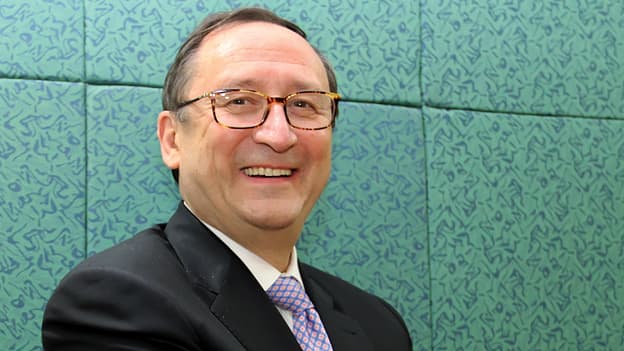Live the company's culture everyday: Q&A with John Haley

Being in charge means that you get to decide and you need to be as open as you can in the process of making a decision
You need to explain to people what you are thinking and need to hear what they think. But once you have made a decision you move on
John Haley, Chairman and CEO of Towers Watson, in a freewheeling conversation with People Matters about the importance of grooming leaders from within the organisation, his career through two mergers and his management philosophy
You have been in the same organisation for 36 years. That is a long time. Tell me a little about your journey.
I started my career as a consultant at The Wyatt Company, working on retirement plans. At some point, I started to manage a small team of about eight to 10 people, but it was purely consulting for 15 years for some great clients like IBM, GE, General Motors and AT&T - they were smart people who wanted to do the right thing. At that time, The Wyatt Company was decentralised and each office ran independently for the most part. The Washington office was our biggest, most successful and most prestigious office.
I applied for the position to lead the Washington office and despite my conviction that I would be selected, I wasn’t. They brought somebody in from San Francisco to run the office. I called up that guy, Pete Smith, and told him that I would do what I could to help him be successful and that was the start of a great relationship. I worked for him for two years in the Washington office and then he became the CEO and I took over his role as the head of the Washington office. I moved on to the Executive Committee and while I was there we made a lot of changes in the organisation.
What kind of changes?
We took it from a decentralised company to a matrix organisational structure organised by region, geography and lines of business. My next move was to head the largest line of business. I negotiated the financial terms of the deal when The Wyatt Company got together with Watson and Sons, which was the largest partnership in the UK. It was a year, or to be more precise, an 11-month negotiation to finalise that deal and with it Watson & Sons became Watson Wyatt Partners and The Wyatt Company became Watson Wyatt & Company. In 1995, I moved on to the partnership board of Watson Wyatt Partners and gained exposure working overseas. In 1997, I worked on closing down a very unprofitable partner operation that was affecting the health of the whole company. After that, I was elected CEO.
We went public in 2000 and were the first HR consulting firm to do that. I expected consolidation in the industry and by going public we were able to take advantage of that. We did acquisitions during the 2000s. We formally acquired Watson Wyatt Partners in 2005. We bought the largest firms in Germany and the Netherlands. Then in 2010 we merged with Towers Perrin and today we are the biggest global HR consulting firm.
How was the transition from being an expert consultant to handling the Washington office?
The best thing that ever happened to me was that I didn’t get selected the first time to head the Washington D.C. office. I wasn’t actually prepared for it. I learned a lot about management from working with Pete Smith. One of the things Pete taught me was the importance of listening to people, soliciting their ideas about what to do and communicating what you were doing. When I first became a manager, I made a lot of mistakes. I had some ideas about things I thought needed to change and the direction we needed to move in. There were some folks who were opposed to these ideas. I knew they would never be on my side, but I spent a lot of time trying to get them to come around. With that experience in mind, when I became CEO I was in a similar situation about wanting to take things in a certain direction but I didn’t waste time trying to confront people who I knew I could never convince.
Being in charge means that you get to decide and you need to be as open as you can in the process of making a decision: You need to explain to people what you are thinking and need to hear what they think. But once you have made a decision you move on.
You said you got elected as a CEO. How does that process happen in a firm like yours?
It was a privately-held company at that time. The board of directors, who were all internal folks, voted on who the next CEO would be. They notified the company about the vacancy and asked for applications. Pete Smith, the outgoing CEO, asked anybody who was interested to let him know. There were two of us who stepped forward. Pete and the gentleman who was the head of Asia-Pacific at that time brought in an external person who was in charge of a professional services business and the three of them interviewed us. We made a presentation to the board about a better vision for the future. That was the process we went through.
So, in the history of the company, the CEO has always been an internal pick?
Yes, we have never brought somebody in from outside to run the firm. Frankly, I think when I step down it should be an internal person who replaces me as well. The reason I say that is because in a consulting firm, particularly when the firm is doing well, there is a culture, which is really important to respect. It is very hard to get it from outside. People can get it, but they just don’t get it immediately. And if you want to maintain some continuity, it is very important. If the firm is totally failing, maybe you need someone coming in from the outside, but if it is in a reasonably good shape, I do think somebody internal is very important.
You have a very balanced management team. Your gender ratio is very healthy which is very surprising considering the industry you operate in. How have you been able to manage it?
We have been lucky. We have some tremendously talented women. Tricia Guinn who heads our Risk and Financial Services segment and Julie J. Gebauer who heads Talent and Rewards, are exceptional. I think at the very top, middle and at the bottom we have a good balance. Unfortunately, we don’t have a good balance in the upper middle. That is something we are working on. The longest running initiative right now is diversity inclusion. It is a multi-year initiative. For a long while, I used to think the secret to inclusion was making sure you didn’t have barriers. But now I think it means you have to work proactively to make sure you do things so you attract as many people with diverse backgrounds as possible.
You have teams across geographies that traditionally come from different companies consolidating with you across the globe. How do you keep that culture or the brand as one?
The most important thing you can do is to live that culture everyday. You need to make sure people see you live up to the values the organisation stands for. You have to tell stories that illustrate the values and the culture of the organisation and it’s through those stories that people pick up on the way they are expected to behave. The composition of my management team is almost equally divided between people from Towers Perrin and Watson Wyatt. I tend to focus on deciding what we want to do and where we want to go, and relatively little on exactly how we are going to do it. I try not to micromanage things.
I am happy to talk with people if they have questions about what to do. If someone is reporting to me I tell them with 85 per cent of the decisions that come up you should just do what you think is right; 13 per cent of decisions you should call me and tell me what you are going to do; and about 2 per cent of the time you will ask me what you should do. This is not the actual formula and if I think something should be changed, I will talk with them.










